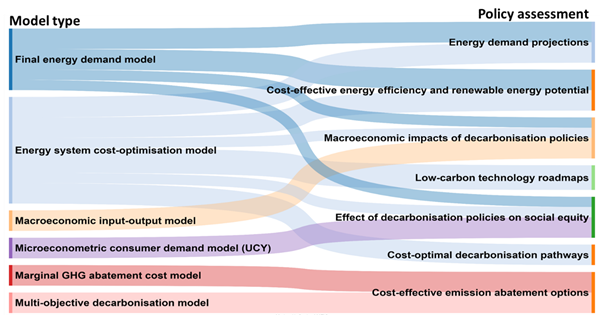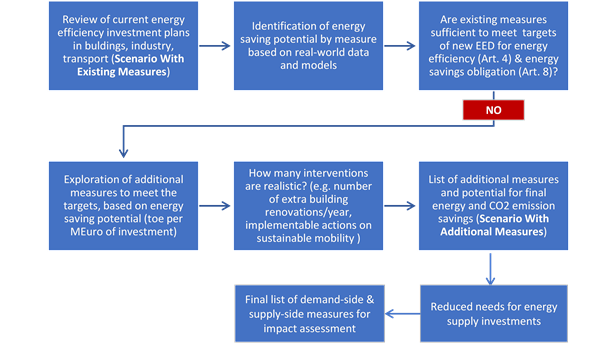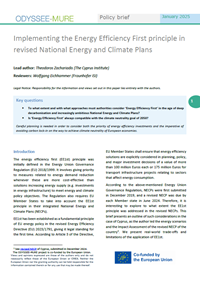Summary
Key questions
- To what extent and with what approaches must authorities consider ‘Energy Efficiency First’ in the age of deep decarbonisation and increasingly ambitious National Energy and Climate Plans?
- Is ‘Energy Efficiency First’ always compatible with the climate neutrality goal of 2050?
Careful planning is needed in order to consider both the priority of energy efficiency investments and the imperative of avoiding carbon lock-in on the way to achieve climate neutrality of European economies.
Lead authors: Theodoros Zachariadis (The Cyprus Institute)
Reviewers: Wolfgang Eichhammer (Fraunhofer ISI)
Introduction
The energy efficiency first (EE1st) principle was initially defined in the Energy Union Governance Regulation (EU) 2018/1999. It involves giving priority to measures related to energy demand reduction whenever these are more cost-effective than solutions increasing energy supply (e.g. investments in energy infrastructure) to meet energy and climate policy objectives. The Regulation also requires EU Member States to take into account the EE1st principle in their integrated National Energy and Climate Plans (NECPs).
EE1st has been established as a fundamental principle of EU energy policy in the revised Energy Efficiency Directive (ΕU) 2023/1791, giving it legal standing for the first time. According to Article 3 of the Directive, EU Member States shall ensure that energy efficiency solutions are explicitly considered in planning, policy, and major investment decisions of a value of more than 100 million Euros each or 175 million Euros for transport infrastructure projects relating to sectors that affect energy consumption.
According to the above-mentioned Energy Union Governance Regulation, NECPs were first submitted in December 2019, and a revised NECP was due by each Member state in June 2024. Therefore, it is interesting to explore to what extent the EE1st principle was addressed in the revised NECPs. This brief presents an outline of such considerations in the case of Cyprus, as the author led the energy scenarios and the Impact Assessment of the revised NECP of the country1. We present real-world trade-offs and limitations of the application of EE1st.
Figure 1: Techno-economic models developed to address energy and climate policy questions in Cyprus

Source: Author
Analytical framework
During the last 15 years, we have developed several energy-economy-environment models to address policy questions raised by the government of Cyprus, ranging from long-term energy demand projections to socio-economic impact assessments of increasingly ambitious energy and climate strategies. Figure 1 illustrates the models we have developed and their use in different policy analyses. At the same time, many policy questions require analysis of individual measures on the basis of basic techno-economic calculations without sophisticated modelling. Therefore, to assess the interaction of measures aligned with EE1st and measures that can help the country attain its climate targets for 2030 and 2050, a combination of model-based and simpler methods is necessary. Some insights from these interactions are described in the next section.
Addressing EE1st – Procedure and outcome
The procedure that we followed, in close collaboration with national energy authorities, is summarized in Figure 2.
(a) Checking the adequacy of existing measures
As a first step, we explored all investments that are already foreseen and officially approved in the National Recovery and Resilience Plan (RRP), the European Structural and Investment Funds (from the EU’s regular budget, i.e. the Multi-Annual Financial Framework 2021-27), the approved Just Transition Plan, the funding secured from the Connecting Europe Facility on electricity interconnection, and sustainable mobility investments or expenditures foreseen in the national budget of the Ministry of Transport.
Since many of the investments in energy renovations provide funding both for energy saving interventions (e.g. roof insulation, installation of double-glazed windows, conversion of buildings to near-zero energy buildings etc.) and for the installation of solar PV panels in buildings, it is appropriate to distinguish the portion of the funds devoted to energy efficiency and that which goes to renewable energy investments. The allocation of the funds is different for each investment because it depends on the kind of interventions supported by each project. For example, building renovations supported by the RRP have different requirements from the corresponding renovations supported by the Structural Funds. The allocation of investment amounts between energy saving and renewable energy measures has been conducted on the basis of detailed information obtained by officers from the national Ministry of Energy.
Figure 2: Procedure to reach realistic energy efficiency measures in the draft revised NECP of Cyprus

Source: Author
The overall picture from this exercise was that over 4 billion Euros are already foreseen (and are accounted for in the revised Scenario with Existing Measures – WEM – of the NECP) for the low-carbon energy transition of Cyprus, but a very substantial portion will be devoted to the electricity interconnection of the country. Sustainable mobility and electric mobility will receive close to one quarter of the total funds, or about 1.1 billion Euros. Energy efficiency investments in buildings and industry, however, will receive comparatively lower amounts, just over 250 million Euros, up to 2030.
(b) Identifying additional measures
We therefore concluded that energy renovations must receive stronger support in the NECP’s Scenario With Additional Measures – WAM. To assess the additional investments needed, we then followed a twin approach:
i) First, we collected information on the additional funds which are planned by governmental authorities for green actions, such as additional investments proposed by the government of Cyprus to the European Commission for the REPowerEU chapter of the revised national Recovery and Resilience Plan, projects that have been included in the approved Just Transition Plan of the country, for which only a part of their budget has been already included to be financed by the Just Transition Fund, projects aiming to alleviate energy and transport poverty with the aid of the newly decided Social Climate Fund (SCF)2, which is scheduled to start one year before the introduction of the new Emissions Trading System (ETS 2), i.e. in 2026, announced plans for further investments for energy efficiency improvements in industry and restoration of waste disposal facilities, and additional sustainable mobility investments that have been provided by the Ministry of Transport as part of the WAM scenario.
ii) Especially for energy renovations in buildings, we found that the additional funds are insufficient to reach the energy savings foreseen in the WAM scenario of this NECP revision. Therefore, we conducted a specific analysis about the additional building renovations (and the accompanying funds) that are necessary to enable energy savings consistent with the WAM scenario. For this purpose, we obtained data from the Ministry of Energy on the number of renovation grants awarded up to now, the estimated final energy savings per renovation, and the aid intensity per category of renovation, depending on full or partial renovations, aid to regular or vulnerable households, etc.
Then we performed an assessment of the amount of renovations that need to be financially supported up to 2030. Our assessment showed that, apart from the funds planned in the revised RRP and the funds to be available from the SCF as mentioned above, additional public funds up to 100 million Euros will have to be provided up to 2030 for renovations of private dwellings as well as of buildings in the public sector and in private enterprises. Total investments mobilised can amount to over 200 million Euros. Such measures, in the form of direct public investments and support schemes to the private sector, will also involve the installation of PV panels – but the main portion of these funds must be devoted to energy efficiency actions. Together with the investments from the RRP and the SCF, these funds correspond to about 3000 building renovations per year – in private dwellings, businesses, the public sector, and vulnerable households – for each year of the period 2024-2030. This requires a strong acceleration of today’s renovation rates, which involve less than 2000 renovations per year.
In summary, the total additional investment needs to implement the WAM scenario shown were calculated at close to 500 million Euros of extra public funds, intended to mobilise total investments of up to 1.1 billion Euros by 2030. Additional investments in the WAM scenario, not shown here, were selected by authorities for GHG emissions reduction but not related to energy efficiency.
In short, policies related to EE1st in the revised NECP of Cyprus, which were selected under interaction between policy maker choices and model-based work, are the following:
- Cost-effective policies and measures that are related to energy efficiency have been included in the NECP’s WAM scenario to an extent that has not been observed in the past. All these measures, at the time of their implementation, have a negative or near-zero total lifetime cost and are therefore cost-effective. Further energy efficiency measures risk being unrealistic to implement (e.g. an even stronger increase in the number of energy renovations of buildings up to 2030 would require extremely high financial and human resources to realise). This finding is based on two relevant studies mentioned in the NECP, as well as analyses conducted by the authors in the determination of additional renovation measures as explained above.
- The WAM scenario foresees energy efficiency measures in transport (modal shift towards public transport and micromobility, as well as electrification of cars), which involve significant investments that reach unprecedented levels for the standards of the Cypriot transport system. This indicates a strong consideration of EE1st.
- Further prioritising demand-side measures such as energy efficiency improvements would put Cyprus at risk of strong divergence from two main objectives of the ‘Fit for 55’ package which are related to energy supply: the renewable energy deployment targets and the reduction in emissions of ETS sectors – which in the case of Cyprus is predominantly fossil fuel-based power generation that needs strong decarbonization.
- A further policy scheduled to be implemented in mid-2025 is carbon pricing in non-ETS sectors of the economy. This can indeed stimulate further efficiency improvements and fossil fuel substitution by low- or zero-carbon energy forms. In fact, carbon pricing is in line with the Commission’s EE1st guidance, mentioning that Member states are encouraged to “internalise to the fullest possible extent the environmental and climate costs of energy alternatives”.
At the same time, the application of EE1st has helped avoiding additional investments in energy supply. According to initial projections, Cyprus would need to add three additional thermal power plants burning natural gas by 2025 to meet the increasing demand for electricity, taking into account constraints in the deployment of renewables. Our model calculations, however, showed that the additional energy efficiency measures of the WAM scenario could render one of the three plants redundant until 2030, saving several million Euros of investment costs.
Challenges to ensure consistency of EE1st with the climate neutrality goal
Although EE1st can contribute both to meeting the new EED objectives and to the broader energy and climate targets for 2030, compatibility with the long-term goal to reach net zero emissions by 2050 needs to be carefully considered. As outlined in the introduction, EU legislation asks to opt for energy demand reduction measures if they are cost-effective compared to energy supply increases. However, there are cases where simple energy efficiency interventions may be more cost-effective, i.e. may save more energy per thousand Euros of investment, but may lock the economy in a path that does not lead to zero emissions in 2050. For example, replacement of oil-fired boilers with gas-fired boilers in industries using low- and medium-temperature processes may be more cost-effective than the replacement with heat pumps. However, the energy saving potential of the former solutions is comparatively low. Given that the lifetime of renovations and equipment can reach several decades, such investments are not consistent with a path to net zero emissions by 2050.
Another issue that has to be considered is the need to secure electricity supply on the way to climate neutrality, even if some measures improving energy security may not seem to be cost-effective. A zero-carbon economy will be almost fully electrified (with electricity coming from renewables and perhaps from some fossil fuel use coupled with carbon capture technologies). This means that EU-wide electricity consumption may more than double by 2050. This calls for extremely careful planning to secure uninterrupted and high-quality supply of electricity, which requires huge investments in digitizing, modernizing, and expanding the electricity grid. Some of these investments may be cost-effective in the strict sense and, hence, may seem to be out of the EE1st priorities. However, they may be necessary to protect energy systems against “tail risks”, i.e. events of low probability but severe impacts. In such cases, proper application of EE1st will help reduce the need for an over-dimensioned electricity infrastructure, which will facilitate the net zero transition.
Notes
- 1: See revised NECP of Cyprus, submitted in December 2024.
- 2: See the Social Climate Fund Regulation (EU) 2023/955.






